MENU
The Electronic Scholarly Publishing Project: Providing access to classic scientific papers and other scholarly materials, since 1993. More About: ESP | OUR CONTENT | THIS WEBSITE | WHAT'S NEW | WHAT'S HOT
Comparative Timelines
The ESP Timeline (one of the site's most popular features) has been completely updated to allow the user to select (using the timeline controls above each column) different topics for the left and right sides of the display.
Select:
New Left Column
New Left Column
Dates
Decade
New Right Column
New Right Column
 On April 6, the Church of Jesus Christ of Latter-Day Saints is founded by Joseph Smith Jr. (1805-1844), in Fayette, New York. In Palmyra, New York, The Book of Mormon is published for the first time; Smith has translated it, he says, from golden tablets he found buried near Palmyra.
On April 6, the Church of Jesus Christ of Latter-Day Saints is founded by Joseph Smith Jr. (1805-1844), in Fayette, New York. In Palmyra, New York, The Book of Mormon is published for the first time; Smith has translated it, he says, from golden tablets he found buried near Palmyra.
The first wagon trains to cross the Rocky Mountains arrived in California.
The U.S. Congress passes the Indian Removal Act.
The world's population tops 1,000,000,000 (it had been roughly 750 million only 50 years earlier).
1830
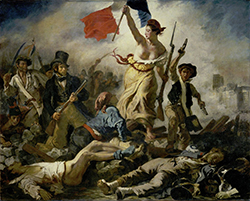 Painting by Eugène Delacroix: Liberty Leading the People (French: La Liberté guidant le peuple) commemorates the July Revolution of 1830, which toppled King Charles X of France. A woman personifying the concept and the Goddess of Liberty leads the people forward over a barricade and the bodies of the fallen, holding the flag of the French Revolution — the tricolour flag, which remains France's national flag — in one hand and brandishing a bayonetted musket with the other. The figure of Liberty is also viewed as a symbol of France and the French Republic known as Marianne. By the time Delacroix painted Liberty Leading the People, he was already the acknowledged leader of the Romantic school in French painting.
Painting by Eugène Delacroix: Liberty Leading the People (French: La Liberté guidant le peuple) commemorates the July Revolution of 1830, which toppled King Charles X of France. A woman personifying the concept and the Goddess of Liberty leads the people forward over a barricade and the bodies of the fallen, holding the flag of the French Revolution — the tricolour flag, which remains France's national flag — in one hand and brandishing a bayonetted musket with the other. The figure of Liberty is also viewed as a symbol of France and the French Republic known as Marianne. By the time Delacroix painted Liberty Leading the People, he was already the acknowledged leader of the Romantic school in French painting.
Nat Turner leads a slave rebellion in Southampton, Virginia, killing at least 57 whites. Hundreds of black slaves are killed in retaliation.
Alabama makes it illegal for enslaved or free blacks to preach.
 In Boston, William Lloyd Garrison founds the abolitionist newspaper, The Liberator, signaling a dramatic shift in the antislavery movement. In the previous decades, it had centered in the South and favored a combination of compensated emancipation and colonization of freed slaves back to Africa. In the 1830s, the abolitionist movement becomes the dominant voice among antislavery advocates. Abolitionists demand the immediate end to slavery, which they consider to be a moral evil, without compensation to slaveowners.
In Boston, William Lloyd Garrison founds the abolitionist newspaper, The Liberator, signaling a dramatic shift in the antislavery movement. In the previous decades, it had centered in the South and favored a combination of compensated emancipation and colonization of freed slaves back to Africa. In the 1830s, the abolitionist movement becomes the dominant voice among antislavery advocates. Abolitionists demand the immediate end to slavery, which they consider to be a moral evil, without compensation to slaveowners.
Nat Turner, a literate slave who believes he is chosen to be the Moses of his people, instigates a slave revolt in Virginia. He and his followers kill 57 whites, but the revolt is unsuccessful and up to 200 slaves are killed. After an intense debate, the Virginia legislature narrowly rejects a bill to emancipate Virginia's slaves. The widespread fear of slave revolts, compounded by the rise of abolitionism, leads legislatures across the South to increase the harshness of their slave codes. Also, expressions of anti-slavery sentiment are suppressed throughout the South through state and private censorship.
North Carolina enacts a statute that bans teaching enslaved people to read and write.
Slave Revolt: Virginia Slave preacher Nat Turner leads a two-day uprising against whites, killing about 60. Militiamen crush the revolt then spend two months searching for Turner, who is eventually caught and hanged. Enraged Southerners impose harsher restrictions on their slaves.
1831
(no entry for this year)
Oberlin College is founded in Ohio. It admits African-Americans. By 1860, one third of its students are black.
 Electric telegraph invented by Samuel Morse.
Electric telegraph invented by Samuel Morse.
1832
 In Vienna, kitchen apprentice Franz Sacher, 16, creates what comes to be known as Sachertorte, for a dinner in honor of Austria's Prince Klemens Wenzel von Metternich.
In Vienna, kitchen apprentice Franz Sacher, 16, creates what comes to be known as Sachertorte, for a dinner in honor of Austria's Prince Klemens Wenzel von Metternich.
The American Anti-Slavery Society is established in Philadelphia.
The British Parliament abolishes slavery in the entire British Empire.
1833
(no entry for this year)
South Carolina bans the teaching of blacks, and slave or free, in its borders.
Federal troops are ordered to put down a riot by workers along the Chesapeake and Ohio Canal. It is the first time federal troops have been used to settle a labor battle in the United States.
1834
(no entry for this year)
Texas declares its independence from Mexico. In its constitution as an independent nation, Texas recognizes slavery and makes it difficult for free blacks to remain there.
Southern states expel abolitionists and forbid the mailing of antislavery propaganda.
 The first volume of La Dèmocracie en Amèrique (Democracy in America), by Alexis de Tocqueville (1805-1859), is published in France. Tocqueville, a historian and politician and member of the French aristocracy, writes about the American people and their institutions, based on his 9 months of travels through the United States and eastern Canada in 1831-1832.
The first volume of La Dèmocracie en Amèrique (Democracy in America), by Alexis de Tocqueville (1805-1859), is published in France. Tocqueville, a historian and politician and member of the French aristocracy, writes about the American people and their institutions, based on his 9 months of travels through the United States and eastern Canada in 1831-1832.
1835
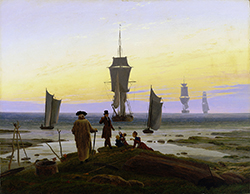 Painting by Caspar David Friedrich: The Stages of Life (German: Die Lebensstufen) is an allegorical oil painting completed just five years before his death. This picture, like many of his works, forms a meditation both on his own mortality and on the transience of life. The painting is set on a sea shore and shows in the foreground an aged man with his back turned to the viewer, walking towards two adults and two children on a hilltop overlooking a harbour. The figures are echoed by five ships shown in the harbour, each at a different distance from the shore, an allegorical reference to the different stages of human life, to the end of a journey, to the closeness of death. The figures have been identified as Friedrich and his family. The aged man is the artist himself, the small boy is his young son Gustav Adolf, the young girl is his daughter Agnes Adelheid, the older girl is his daughter Emma, and the man in the top hat is his nephew Johann Heinrich.}The Stages of Life (German: Die Lebensstufen) is an allegorical oil painting of 1835 by the German Romantic landscape painter Caspar David Friedrich. Completed just five years before his death, this picture, like many of his works, forms a meditation both on his own mortality and on the transience of life. The painting is set on a sea shore and shows in the foreground an aged man with his back turned to the viewer, walking towards two adults and two children on a hilltop overlooking a harbour. The figures are echoed by five ships shown in the harbour, each at a different distance from the shore, an allegorical reference to the different stages of human life, to the end of a journey, to the closeness of death. The figures have been identified as Friedrich and his family. The aged man is the artist himself, the small boy is his young son Gustav Adolf, the young girl is his daughter Agnes Adelheid, the older girl is his daughter Emma, and the man in the top hat is his nephew Johann Heinrich.
Painting by Caspar David Friedrich: The Stages of Life (German: Die Lebensstufen) is an allegorical oil painting completed just five years before his death. This picture, like many of his works, forms a meditation both on his own mortality and on the transience of life. The painting is set on a sea shore and shows in the foreground an aged man with his back turned to the viewer, walking towards two adults and two children on a hilltop overlooking a harbour. The figures are echoed by five ships shown in the harbour, each at a different distance from the shore, an allegorical reference to the different stages of human life, to the end of a journey, to the closeness of death. The figures have been identified as Friedrich and his family. The aged man is the artist himself, the small boy is his young son Gustav Adolf, the young girl is his daughter Agnes Adelheid, the older girl is his daughter Emma, and the man in the top hat is his nephew Johann Heinrich.}The Stages of Life (German: Die Lebensstufen) is an allegorical oil painting of 1835 by the German Romantic landscape painter Caspar David Friedrich. Completed just five years before his death, this picture, like many of his works, forms a meditation both on his own mortality and on the transience of life. The painting is set on a sea shore and shows in the foreground an aged man with his back turned to the viewer, walking towards two adults and two children on a hilltop overlooking a harbour. The figures are echoed by five ships shown in the harbour, each at a different distance from the shore, an allegorical reference to the different stages of human life, to the end of a journey, to the closeness of death. The figures have been identified as Friedrich and his family. The aged man is the artist himself, the small boy is his young son Gustav Adolf, the young girl is his daughter Agnes Adelheid, the older girl is his daughter Emma, and the man in the top hat is his nephew Johann Heinrich.
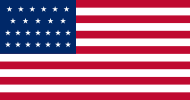 The US flag is modified to have twenty-five stars, reflecting the addition of one new state: Arkansas.
The US flag is modified to have twenty-five stars, reflecting the addition of one new state: Arkansas.
 Davy Crockett killed, as Texans are defeated by the Mexican army at the Alamo.
Davy Crockett killed, as Texans are defeated by the Mexican army at the Alamo.
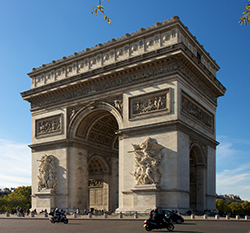 In Paris, the Arc de Triomphe is completed. The arch was ordered built by Napoleon in 1806.
In Paris, the Arc de Triomphe is completed. The arch was ordered built by Napoleon in 1806.
 Texas gains independence from Mexico after winning the battle of San Jacinto.
Texas gains independence from Mexico after winning the battle of San Jacinto.
1836
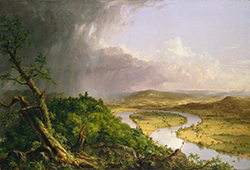 Painting by : View from Mount Holyoke, Northampton, Massachusetts, after a Thunderstorm, commonly known as The Oxbow, is a seminal landscape painting by Thomas Cole, founder of the Hudson River School. The painting depicts a Romantic panorama of the Connecticut River Valley just after a thunderstorm. It has been interpreted as a confrontation between wilderness and civilization.
Painting by : View from Mount Holyoke, Northampton, Massachusetts, after a Thunderstorm, commonly known as The Oxbow, is a seminal landscape painting by Thomas Cole, founder of the Hudson River School. The painting depicts a Romantic panorama of the Connecticut River Valley just after a thunderstorm. It has been interpreted as a confrontation between wilderness and civilization.
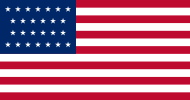 The US flag is modified to have twenty-six stars, reflecting the addition of one new state: Michigan.
The US flag is modified to have twenty-six stars, reflecting the addition of one new state: Michigan.
 Martin Van Buren becomes eighth president of the United States.
Martin Van Buren becomes eighth president of the United States.
 William IV, King of Great Britain, dies.
William IV, King of Great Britain, dies.
1837
 Twice-told Tales, by Nathaniel Hawthorne, is published and is an immediate best-seller.
Twice-told Tales, by Nathaniel Hawthorne, is published and is an immediate best-seller.
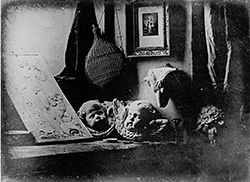 Daguerreotype by Louis Daguerre: Still life with plaster casts is the earliest, reliably dated daguerreotype.
Daguerreotype by Louis Daguerre: Still life with plaster casts is the earliest, reliably dated daguerreotype.
 Coronation of Victoria as queen of Great Britain.
Coronation of Victoria as queen of Great Britain.
1838
 The Seraphim and Other Poems, by Elizabeth Barrett Browning (1806-1861), is published.
The Seraphim and Other Poems, by Elizabeth Barrett Browning (1806-1861), is published.
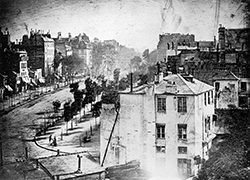 Daguerreotype by Louis Daguerre: The earliest reliably dated photograph of people, taken one spring morning in 1838 from the window of the Diorama, where Daguerre lived and worked. It bears the caption huit heure du matin (8 a.m.). Though it shows the busy Boulevard du Temple, the long exposure time (about ten or twelve minutes) meant that moving traffic cannot be seen; however, the bootblack and his customer at lower left remained still long enough to be distinctly visible. The building signage at the upper left shows that the image is laterally (left-right) reversed, as were most daguerreotypes.
Daguerreotype by Louis Daguerre: The earliest reliably dated photograph of people, taken one spring morning in 1838 from the window of the Diorama, where Daguerre lived and worked. It bears the caption huit heure du matin (8 a.m.). Though it shows the busy Boulevard du Temple, the long exposure time (about ten or twelve minutes) meant that moving traffic cannot be seen; however, the bootblack and his customer at lower left remained still long enough to be distinctly visible. The building signage at the upper left shows that the image is laterally (left-right) reversed, as were most daguerreotypes.
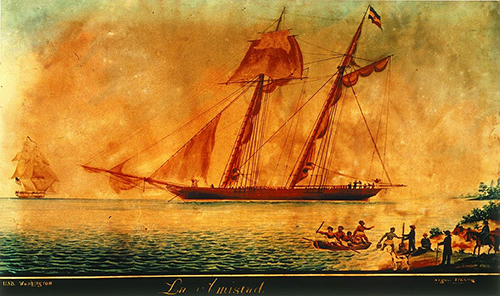 La Amistad was a 19th-century two-masted schooner, owned by a Spaniard living in Cuba. It became renowned in July 1839 for a slave revolt by Mende captives, who had been enslaved in Sierra Leone, and were being transported from Havana, Cuba to their purchasers' plantations. The African captives took control of the ship, killing some of the crew and ordering the survivors to sail the ship to Africa. The Spanish survivors secretly maneuvered the ship north, and La Amistad was captured off the coast of Long Island by the brig USS Washington. The Mende and La Amistad were interned in Connecticut while federal court proceedings were undertaken for their disposition. The owners of the ship and Spanish government claimed the slaves as property; but the US had banned the African trade and argued that the Mende were legally free. Because of issues of ownership and jurisdiction, the case gained international attention. Former president John Quincy Adams argued on behalf of the slaves when the appeal was brought before the U.S. Supreme Court, which eventually determined the Africans to be free men. The case became a symbol in the United States in the movement to abolish slavery.
La Amistad was a 19th-century two-masted schooner, owned by a Spaniard living in Cuba. It became renowned in July 1839 for a slave revolt by Mende captives, who had been enslaved in Sierra Leone, and were being transported from Havana, Cuba to their purchasers' plantations. The African captives took control of the ship, killing some of the crew and ordering the survivors to sail the ship to Africa. The Spanish survivors secretly maneuvered the ship north, and La Amistad was captured off the coast of Long Island by the brig USS Washington. The Mende and La Amistad were interned in Connecticut while federal court proceedings were undertaken for their disposition. The owners of the ship and Spanish government claimed the slaves as property; but the US had banned the African trade and argued that the Mende were legally free. Because of issues of ownership and jurisdiction, the case gained international attention. Former president John Quincy Adams argued on behalf of the slaves when the appeal was brought before the U.S. Supreme Court, which eventually determined the Africans to be free men. The case became a symbol in the United States in the movement to abolish slavery.
Sultan Abdulmecid I implemented the Tanzimat reforms in an attempt to modernize the Ottoman Empire and strengthen it against European powers. The reforms included changes to the legal system, education, and the military, and were influenced by western ideas.

 In response to the British opium trade, Lin Zexu wrote a letter to Queen Victoria, urging her to end the opium trade: We find that your country is sixty or seventy thousand li from China. Yet there are barbarian ships that strive to come here for trade for the purpose of making a great profit. The wealth of China is used to profit the barbarians. That is to say, the great profit made by barbarians is all taken from the rightful share of China. By what right do they then in return use the poisonous drug to injure the Chinese people? Even though the barbarians may not necessarily intend to do us harm, yet in coveting profit to an extreme, they have no regard for injuring others. Let us ask, where is your conscience? The letter to the Queen never reached her. Belatedly, it was delivered and published in The Times of London.
In response to the British opium trade, Lin Zexu wrote a letter to Queen Victoria, urging her to end the opium trade: We find that your country is sixty or seventy thousand li from China. Yet there are barbarian ships that strive to come here for trade for the purpose of making a great profit. The wealth of China is used to profit the barbarians. That is to say, the great profit made by barbarians is all taken from the rightful share of China. By what right do they then in return use the poisonous drug to injure the Chinese people? Even though the barbarians may not necessarily intend to do us harm, yet in coveting profit to an extreme, they have no regard for injuring others. Let us ask, where is your conscience? The letter to the Queen never reached her. Belatedly, it was delivered and published in The Times of London.
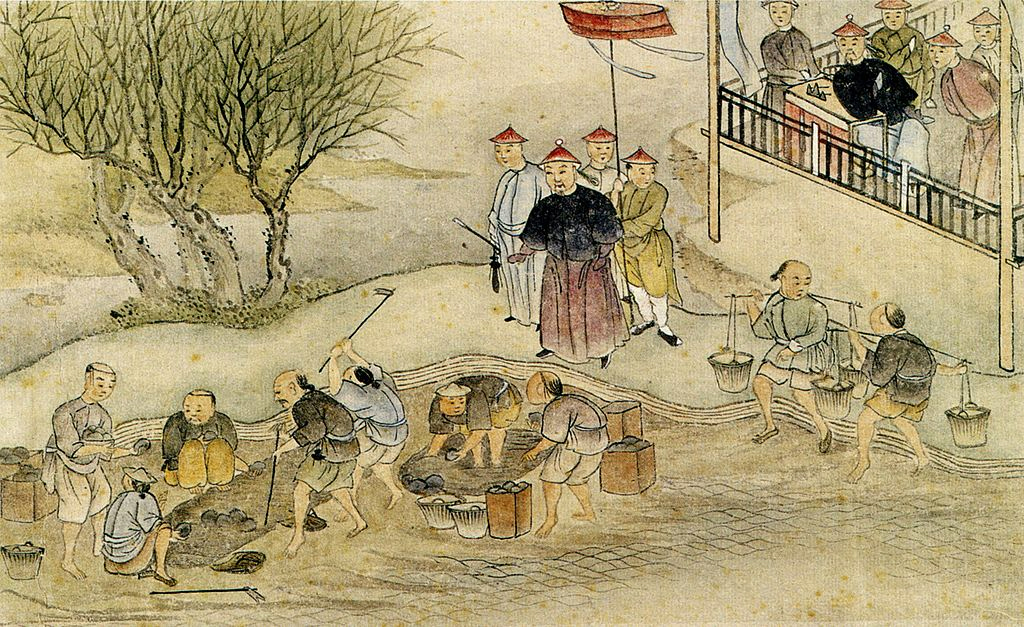 Lin Zexu was a Chinese scholar-official of the Qing dynasty best known for his role in the First Opium War of 1839. In March 1839, Lin arrived in Guangdong Province to take measures that would eliminate the opium trade. He was a formidable bureaucrat known for his competence and high moral standards, with an imperial commission from the Daoguang Emperor to halt the illegal importation of opium by the British. Upon arrival, he made changes within a matter of months. He arrested more than 1,700 Chinese opium dealers and confiscated over 70,000 opium pipes. He initially attempted to get foreign companies to forfeit their opium stores in exchange for tea, but this ultimately failed. Lin resorted to using force in the western merchants' enclave. A month and a half later, the merchants gave up nearly 1.2 million kg (2.6 million pounds) of opium. Beginning 3 June 1839, 500 workers laboured for 23 days to destroy it, mixing the opium with lime and salt and throwing it into the sea outside of Humen Town. Lin composed an elegy apologising to the gods of the sea for polluting their realm.
Lin Zexu was a Chinese scholar-official of the Qing dynasty best known for his role in the First Opium War of 1839. In March 1839, Lin arrived in Guangdong Province to take measures that would eliminate the opium trade. He was a formidable bureaucrat known for his competence and high moral standards, with an imperial commission from the Daoguang Emperor to halt the illegal importation of opium by the British. Upon arrival, he made changes within a matter of months. He arrested more than 1,700 Chinese opium dealers and confiscated over 70,000 opium pipes. He initially attempted to get foreign companies to forfeit their opium stores in exchange for tea, but this ultimately failed. Lin resorted to using force in the western merchants' enclave. A month and a half later, the merchants gave up nearly 1.2 million kg (2.6 million pounds) of opium. Beginning 3 June 1839, 500 workers laboured for 23 days to destroy it, mixing the opium with lime and salt and throwing it into the sea outside of Humen Town. Lin composed an elegy apologising to the gods of the sea for polluting their realm.
The First Opium War between Britain and China occurs between 1839 and 1842, triggered when Chinese officials attempt to prevent the sale of narcotics (opium) to the Chinese people by the British East India trading Company. The British respond by bringing in gunboats and shelling Chinese coastal cities.
 The process of vulcanization, developed by Charles Goodyear, makes possible the commercial use of rubber.
The process of vulcanization, developed by Charles Goodyear, makes possible the commercial use of rubber.
1839
 Voices of the Night, the first book of poems by Henry Wadsworth Longfellow (1807-1882), is published.
Voices of the Night, the first book of poems by Henry Wadsworth Longfellow (1807-1882), is published.
ESP Quick Facts
ESP Origins
In the early 1990's, Robert Robbins was a faculty member at Johns Hopkins, where he directed the informatics core of GDB — the human gene-mapping database of the international human genome project. To share papers with colleagues around the world, he set up a small paper-sharing section on his personal web page. This small project evolved into The Electronic Scholarly Publishing Project.
ESP Support
In 1995, Robbins became the VP/IT of the Fred Hutchinson Cancer Research Center in Seattle, WA. Soon after arriving in Seattle, Robbins secured funding, through the ELSI component of the US Human Genome Project, to create the original ESP.ORG web site, with the formal goal of providing free, world-wide access to the literature of classical genetics.
ESP Rationale
Although the methods of molecular biology can seem almost magical to the uninitiated, the original techniques of classical genetics are readily appreciated by one and all: cross individuals that differ in some inherited trait, collect all of the progeny, score their attributes, and propose mechanisms to explain the patterns of inheritance observed.
ESP Goal
In reading the early works of classical genetics, one is drawn, almost inexorably, into ever more complex models, until molecular explanations begin to seem both necessary and natural. At that point, the tools for understanding genome research are at hand. Assisting readers reach this point was the original goal of The Electronic Scholarly Publishing Project.
ESP Usage
Usage of the site grew rapidly and has remained high. Faculty began to use the site for their assigned readings. Other on-line publishers, ranging from The New York Times to Nature referenced ESP materials in their own publications. Nobel laureates (e.g., Joshua Lederberg) regularly used the site and even wrote to suggest changes and improvements.
ESP Content
When the site began, no journals were making their early content available in digital format. As a result, ESP was obliged to digitize classic literature before it could be made available. For many important papers — such as Mendel's original paper or the first genetic map — ESP had to produce entirely new typeset versions of the works, if they were to be available in a high-quality format.
ESP Help
Early support from the DOE component of the Human Genome Project was critically important for getting the ESP project on a firm foundation. Since that funding ended (nearly 20 years ago), the project has been operated as a purely volunteer effort. Anyone wishing to assist in these efforts should send an email to Robbins.
ESP Plans
With the development of methods for adding typeset side notes to PDF files, the ESP project now plans to add annotated versions of some classical papers to its holdings. We also plan to add new reference and pedagogical material. We have already started providing regularly updated, comprehensive bibliographies to the ESP.ORG site.
ESP Picks from Around the Web (updated 06 MAR 2017 )
Old Science

Weird Science

Treating Disease with Fecal Transplantation
Fossils of miniature humans (hobbits) discovered in Indonesia

Dinosaur tail, complete with feathers, found preserved in amber.
Astronomy

Mysterious fast radio burst (FRB) detected in the distant universe.